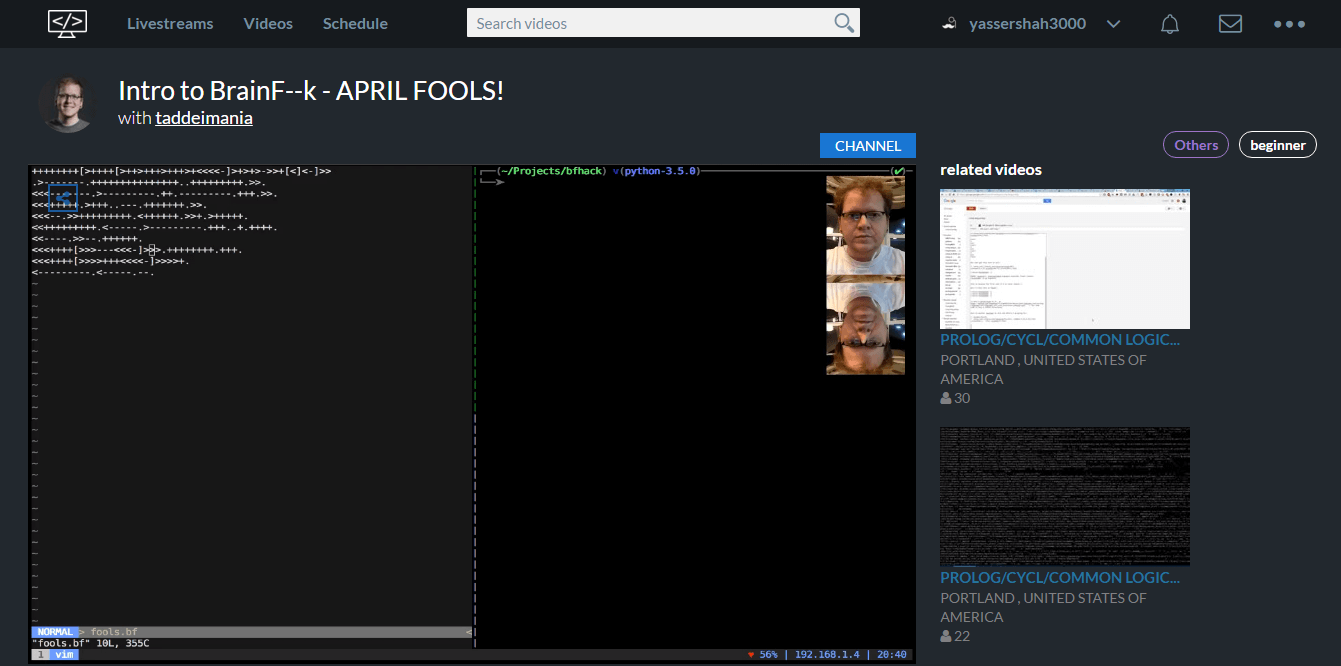
Yup! an architect, you can find all about this very interesting story right here; in words of the “Taddeimania” himself.
Real name: Joel
Alter ego: taddeimania
Location: Greenville, SC, USA
Powers/abilities: Python JavaScript Java C Ruby
Username: https://www.livecoding.tv/taddeimania/
Profession: Software Developer / Instructor
Q: How and why did you find an interest in programming?
A: It started as a need more than an interest. I thought coding was cool in high school but 7 years later when I found my degree in Architecture about as valuable as a paper towel I reevaluated my career path. I remembered my interest in coding from HS and started writing some Perl quest scripts for an emulated Everquest server. That quickly turned into some spreadsheet automation w/ Python and that turned into some community college classes in Java / Oracle. I got a job halfway through my first semester and the rest is history.
Q: Which project have you worked in your career that you are most proud of?
A: That project is definitely guarded by an NDA (non disclosure) otherwise i’d have to say I was very proud of my first “pet project” which was a Fantasy Football web application that pulled its statistics from an NES rom dump. I eventually wrote my own rom parser that extracted the stats and put them directly into the database straight from a file upload.
Q: What is the wackiest programming code that you have written? What happened?
A: As a fun little challenge to myself I created a Quine that writes a copy of itself to an image. It grabs the ascii value of each character in the program and creates a triplet for red, green, and blue pixel values. It then writes the pixels to a matrix and outputs it to an image. In theory you could decode the pixels and write the characters back to a text file to decode the program. See here, I also created a program to analyze magnitudes of audio files containing morse code to output plain readable text.
Q: Please tell us about the analytical dashboard that you are creating?
A: It’s a dashboard that streamers on livecoding.tv can use (or not use) to see their user and follower counts over time. I mention that they can not use it because regardless if they are actively using it, it will track their followers and store them for later. It also uses a social auth login with livecoding.tv so you don’t even have to signup with a username or password.
Q: How would these analytical tools help streamers better understand and target their channel traffic on Livecoding.tv?
A: I have been using it to experiment with what times and topics are most popular. Not only does the app track (and display) your own user counts, it also tracks the total amount of viewers across all channels so you can see what % of site viewers were viewing your stream. It was important to me not just to see if I had a lot or a few users, but what % of site viewers were watching me.
Q: Which language, tools and plugins did you use to create the analytical dashboard?
A: The dashboard is implemented in Python 3 w/ the Django web framework. It has a periodic scheduled task that uses Celery with a rabbitmq task broker to get all viewer counts. It’s all running on AWS EC2 w/ an RDS postgres instance. As for tools, I used Vim as my text editor and Capistrano for deploying the application.
Q: What drawbacks do you think Python embodies apart from basic memory model and the slow speed from the use of an interpreter?
A: The only thing i’ve encountered that Python tends to fall short on because of the global interpreter lock are programs that require any amount of thread management. This could be applications in any industry. I also believe that Python is not in itself a “slow” language. I’ve rarely encountered a bottleneck that existed because of the interpreter – most times it’s an issue with network latency (distributed architecture), or a poorly designed database schema. It’s important to always remember that Python contains all of it’s perf critical code implemented in C, and because of that (and tools like Cython), very performant tools have sprung up that have allowed Python to have a strong presence in the Statistics / Scientific communities. Plus if you’re hung up Python carrying the “slow language” banner, just use PyPy – it runs benchmarks much faster. Fortunately i’m not in the business of watching benchmarks run quickly – I build products 🙂
Q: What was your live stream about on April Fool’s Day?
A: I’m a bit of a weirdo when it comes to April Fool’s, I love a good silly natured prank. Earlier in the day I changed my LinkedIn to announce my new job as a Brainfuck engineer and NOBODY got the joke, so to continue with the joke I decided to stream some “Web Development” in Brainfuck. By the way if you’ve never heard of the language – stop reading this interview and go read the wikipedia… it’s crazy. So yeah, I wanted to be silly so I ruffled up my hair and made a hello world HTML page using brainfuck. Here is the code:
Q: What institute do you teach at South Carolina? How did this transformation from a programmer to a teacher happen?
A: I teach at The Iron Yard. The actual transition from programmer to the instructor was a long and slow process but actually taking the job and jumping into the classroom only took a few months. I had found myself growing more and more interested in mentoring and helping new developers learn to code and jumped at the opportunity to do it full time. It’s been a blast!
Q: What programming courses do you teach in South Carolina? How much does your knowledge in the programming help you deliver an academic lecture?
A: I’ve taught Backend Web & Data Science curriculums so far. Eventually I’ll hopefully teach the Frontend Web class. I feel like my experience with writing code and being a part of the ecosystem/community has helped me deliver the best classroom experience I can. Teaching syntax and covering APIs is only a small part of what I try to help my students with… they are transitioning into a new career and need help navigating those waters so it’s much more important for me to help them become effective learners so that after our short program they can stay efficient in continuing learning all of the new technologies in front of them.
Q: How is the market for programmers in South Carolina?
A: It’s definitely not Silicon Valley or New York here but we are doing a great job filling a shortage of developers here. Fortunately The Iron Yard has campuses across the country and is filling developer shortages everywhere 🙂
Q: What is the most memorable moment you have from your life as a teacher?
A: It’s always demo day and graduation dinner. The amount of growth I see in the students as they have gone from nearly zero experience to pretty confident application developers is always impressive and inspiring. I feel like i’ll never forget any of the graduation dinners.
Check out one of Taddeimania’s recent streams: Intro to BrainF–k – APRIL FOOLS!








